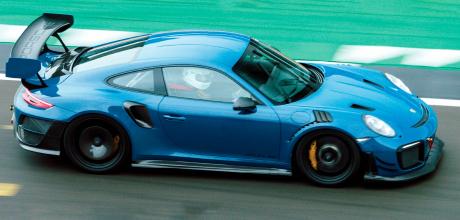Modified Porsche 911 GT2 RS MR 991.2 road and track test
Just how do you go about making one of the standout 991s even better? Total 911 finds out with a road and track test of the GT2 RS MR, from tuning outfit JCR.
Written by Kyle Fortune
Photography by Alisdair Cusick
THE ULTIMATE PORSCHE 991?
Modified 991 GT2 RS MR road and track test
991 GT2 RS MR
Kyle Fortune finds out how some choice upgrades have propelled the fire-breathing 991 GT2 RS to new heights
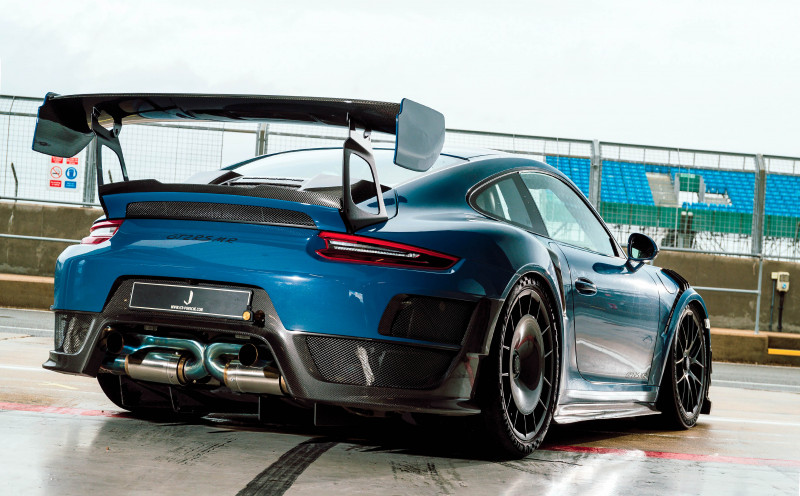
RIGHT JCR’s 911 GT2 RS MR caught the attention of Gunther Werks, which led to the car being fitted with the California-based company’s front spoiler and side skirts.
We’re at Silverstone in winter and it’s raining, somewhat predictably. It looks like the weather gods are playing the same trick they did last time we met the people from JCR Developments to borrow a car. That was a 991 Speedster which, precipitation aside, impressed hugely. At least today we’ll have a roof over our heads. Currently, said roof belongs to a pit garage where the JCR Developments 911 GT2 RS MR, the car we’re here to drive, is parked. It’s chucking it down outside, so photographer Alisdair takes the opportunity to fill his Canon’s memory card, while I chat to JCR Developments’ founder Jonny Cocker.
“What we’re trying to do is demonstrate how our products can improve cars that are already very, very good”
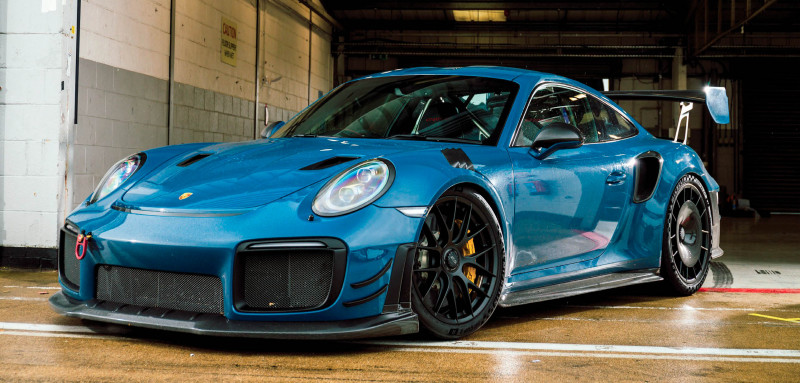
LEFT JCR chose to cover the GT2 RS MR’s carbon-fibre elements on the bonnet and roof in Neptune blue, for a more understated look.
The 991 GT2 RS MR replaces the aforementioned Speedster, the car used to aid refinement of JCR’s products for the 991- and 992-generation GT3. Actually, before the GT2 RS arrived, JCR also had a 992 Turbo S, which like all the cars it runs was a rolling test bed. Explaining the GT2 RS MR, Jonny says: “What we’re trying to do is demonstrate how our products can improve cars that are already very, very good.” Somewhat visibly, too, with JCR attending around 30 track days a year as part of its testing schedule. “This is us saying, ‘Look, this is how much we trust and believe in our products.’ We’re taking what’s already accepted as the best, and enhancing it in what we feel is an all-round, hugely capable platform,” says Jonny.
That testing is largely focused on the exhaust. However, JCR takes a holistic approach to enhancing overall performance, which it’s only too happy to pass on to customers. Today, the car is running a system that’s set up for Clubsport 2 RS cars, although with a few minor adjustments to the tailpipe routing it can also be applied to road cars. This system weighs around 10kg less than the factory system and gains around 20hp in power, with a similar increase in torque. Importantly, says Jonny, it’s also about how the torque is delivered. The desired result is a linear, more immediate response to the throttle pedal – the result of a less-strangled exhaust.
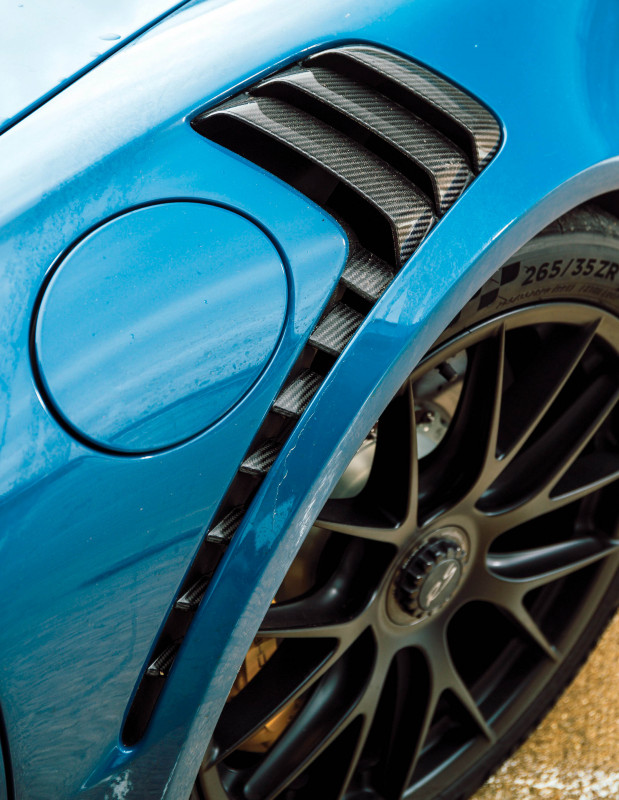
ABOVE Smaller areas of carbon fibre, such as the wheel arch vents, remain in the material’s natural finish
The standard car’s already a hugely potent machine, but without some of the more restrictive constraints that series production requires, there’s the possibility to liberate more. All the track miles help here. JCR is using them for development, durability and material use. Jonny reveals the system on the car today is fitted with three different gauges of Inconel alloys throughout its length, because it enables the technicians to remove even more weight. With the less-restrictive, lighter systems JCR builds and tests so extensively, the turbo response is improved while reducing yet enhancing the sound. This means that JCR can deliver a better-performing, lighter exhaust system, which will enable you to run your car at tracks where sound restrictions are strictly enforced.
Essentially, JCR is taking its previous racing experience in testing cars and applying it to product development. The GT2 RS MR makes sense on a number of levels, not least because it’s a clear statement of intent. And as the most powerful, fastest 911 – in relation to a Nürburgring lap time – it’s also the one that puts the most stress on the components that JCR is developing. The GT2 RS, in Weissach specification, arrived in April, and headed straight to Spa for a few days on an RMA track day. If nothing else, Jonny and the team is consistent in their goal of using the car as intended. It also enabled them to better understand the standard car and set a baseline from which the aim is to improve it.
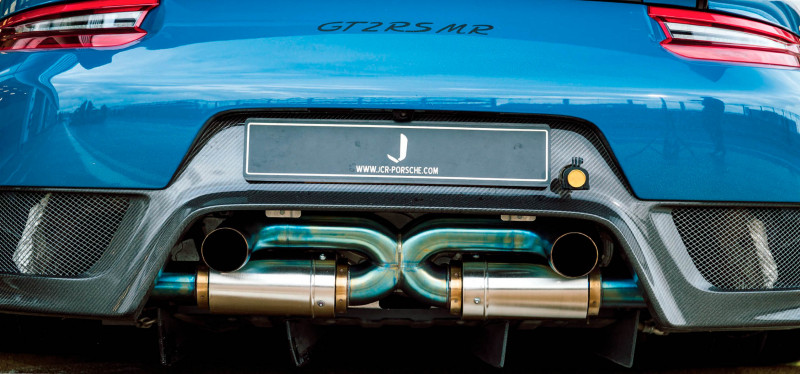
TOP RIGHT The car’s exhaust system has been heavily modified, resulting in a more effective turbo response that’s also quieter – perfect for sound-restrictive track sessions.
Returning from Spa, the car was driven directly to a specialist to have a full Manthey Racing Performance Kit installed. The changes are fairly comprehensive, with Manthey Racing’s KW suspension, a carbon-fibre engine lid, rear bumper, underfloor aero components, new splitter, dive planes, the larger rear wing (this necessitating bonded elements in the chassis to transfer its loads), a larger capacity water tank for the intercooler spray system, and wheel aero discs being installed. The car was set up with Manthey’s recommended baseline setting, from where JCR’s work would start. Jonny thinks Porsche’s standard PCCB setup lacks a little something. Like the Speedster before it, he’s switched it to Surface Transforms’ PCCB replacement brake kit. He prefers the more modular feel of the bite, finding Porsche’s own brakes a bit snappy. On the track this can result in the ABS being triggered, which upsets the balance on the front end… and the front end is such an important facet of the 911’s performance. “It’s a win-win with them. They run cooler, have better performance and they’re lighter,” says Jonny, who runs the Surface Transforms with Pagid RSC1 pads.
Underlining the fact that even early on the RS was doing its intended job of attracting interest, Peter Nam of Gunther Werks got in touch, asking if JCR would like to try some out elements of its GW9 carbon-fibre aero kit. As such, the car now features GW9’s GT2 RS EVO aero front spoiler and Aero side skirts, which don’t just enhance the look, but “picks up a bit of front end” according to Jonny. Following its MR and GW9 fitment, and a number of track days, the 2 RS was sent to Logic VPC for a colour change using its peelable paint process. Not being a huge fan of the Weissach Pack’s exposed carbon fibre on the bonnet and roof, the decision was made to cover them in Neptune blue, a colour you’re more likely to see on a Taycan than a 911. It works here, particularly with all the contrasting black elements, including the fitting of a new set of satin black magnesium wheels. The overall look is relatively understated, if such a statement can ever truly be applied to a GT2 RS MR. It certainly isn’t as shouty as it was in its previous silver, Weissach Packwearing battledress.
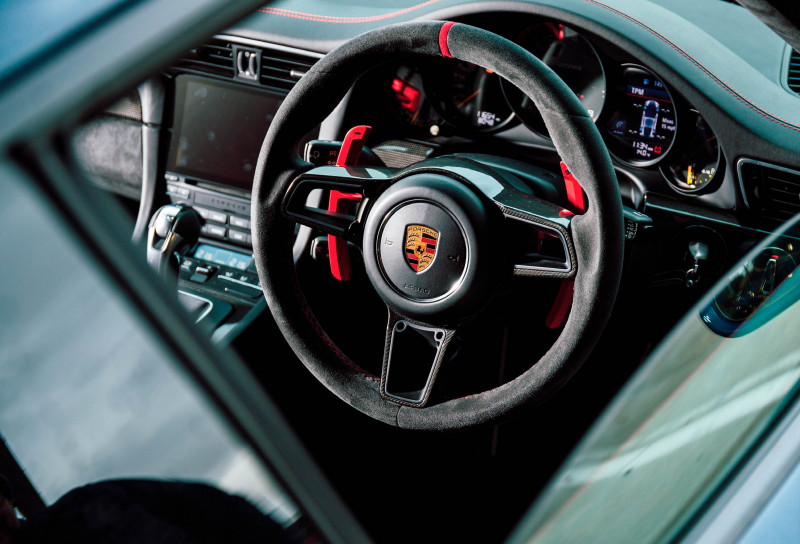
Today, it’s set a number of UK track road car records, its pace putting it between GT4 and GT3 race cars. It’s closer to GT3s where its big power advantage gives it a run on the straights, and GT4s where it’s a bit tighter in the bends. It’s been back to Spa, and bettered Manthey Racing’s own time around the track. JCR has taken the Manthey settings, which are designed to suit the peculiarities of the Nürburgring, and is working on its own. There’s plenty of scope for adjustment, too: the car sits some 25mm lower now, with Jonny revealing they run with a differing, greater rake, too, which benefits the aero. The Manthey setup is also traction biased – something that’s needed around the Green Hell perhaps – but something Jonny doesn’t think is such a priority on GP-style tracks. He says that while wheelspin is possible in first gear in anything above the traction on offer, the combination of tyre and the tractability of the engine means you can pretty much floor the accelerator on the exit of corners.
He might say that, but he’s a trophied racing driver. With plenty of seat time already in the MR he’s not too fussed about taking it out today considering the damp weather. I have no such luxury, but even if I did I’ve got a GT2 RS MR and Silverstone at my disposal, so any thoughts of sensibility leave my head and I fetch my helmet bag from the boot of my car.
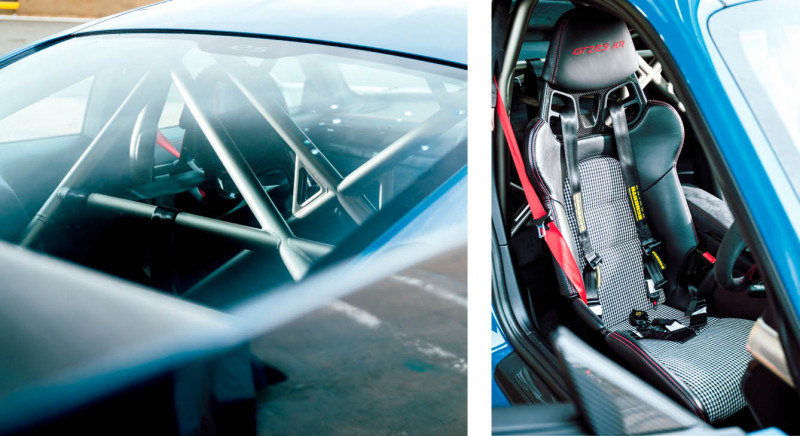
ABOVE AND TOP Pepita inserts are a nice touch to the lightweight bucket seats, while JCR’s own aluminium paddleshifters in red replace the factory-fitted versions.
If that Neptune blue exterior’s already sold me on this car, then climbing into the cabin only adds to the level of want. Pepita makes any Porsche better, and there are some inserts covered in it on the lightweight bucket seats. Other interior changes include the MR-embroidered headrests, and JCR’s own billet aluminium paddleshifters. The latter add some useful reach over the somewhat apologetically small ones that come from the factory.
I roll out of garage 10C and head out on to the track. There’s no heat in the car, so the first few laps are exploratory. I was here a few weeks ago for the 992 GT3 RS launch, and even being sensible with the accelerator the GT2 RS MR’s horsepower advantage underlines why the 2 RS is such a formidable car. It’s shortening the straights much quicker than the 3 RS could, though even in perfect conditions this car would lose a bit of cornering speed to the mighty aero grip-generating 992 GT3 RS.
After a few tentative laps I up the pace, the rain revealing that while there’s no denying the Michelin Pilot Sport Cup 2Rs aren’t suited to the conditions, there’s a finely balanced chassis working beneath me. The steering is most notable. There’s a quickness to its response that I don’t remember from a stock GT2 RS, with that speed and accuracy also coming with a level of feel that’s a little more detailed in its information, too. That’s useful any time, but particularly today when I’m feeling my way around the track, looking for grip off the usual lines. The JCR responds faithfully, even on less-than-optimal rubber. If the turn-in is pleasing, so too is the traction.
Jonny’s not wrong when he says there’s plenty of it, even if I’m not prepared to punch it full bore exiting a corner. Here, prudence dictates that a full push of the throttle’s not wise until I’ve pulled the paddle for third and made sure there’s not even the merest hint of steering lock on. The worsening weather actually helps for once. It’s cleared the track of traffic, so I’ve got the tarmac largely to myself and this gives me an opportunity to get a better feel for what’s going on. Speed? Well, there’s enough of it, with the promise of so much more, but what’s most obvious is the feel – the detailed feedback the car’s giving, and the assurance in the messages.
Rain’s less than ideal, of course, but it’s also revealing. The chassis shows such a benign transition from grip to slip that even though I won’t be breaking any lap records today, there’s real fun to be had, with the odd corrective lock required – sometimes from big angles. The exhaust sounds great: crisper of note with a bassy undertone, although the full effect is slightly muted by the padding of my helmet. The brakes feel fantastic and Jonny’s assertion that the way the turbos work with a little less restriction in the exhaust system is not without merit. The buildup is immediate yet lacking a forceful kick, instead growing in intensity. That’s useful when grip’s at a premium, and feels more natural, too.
Even so, taking the skier’s rule of never doing one last run, I pull into the pit lane wanting another lap, but sated that I’ve discovered enough for now – on track at least. This is a road car, so a quick run outside Silverstone is the order of the day. The detailed feedback from the track doesn’t become intrusively busy on the road. There’s little sense of compromise as the result of the GT2 RS MR’s revisions, with the exception of the need to be a little more circumspect around speed bumps, ramps and suchlike because of the ride height.
The JCR team hasn’t finished its work this week yet, though. Once I hand over the keys they’re off to Snetterton in a bid to set a lap time. Fortunately, the weather’s playing ball, and they do exactly that, shattering the Snetterton 300 road car lap record by 3.86 seconds. That break in the weather closes the track day season for JCR, although one thing’s for sure: it’ll be out and about early in 2023, and we’ll be watching the weather forecast, and those lap times, with interest…


